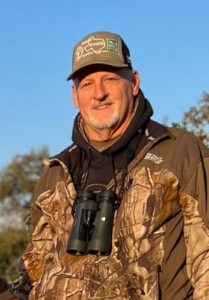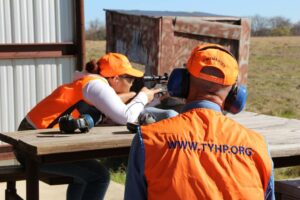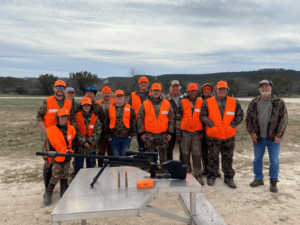A Parent’s Guide to Maximizing the Youth Hunting Experience

by Dale Bode
Although the Texas Youth Hunt Program (TYHP) hosts several archery and shotgun hunts throughout the year, the vast majority of hunts require young hunters to develop the marksmanship skills necessary to ethically harvest a game animal with a modern center-fire rifle. In my six years as a certified huntmaster I have seen the good, the bad, and the ugly of pre-hunt preparation and shooting skills. By no means do I consider myself an expert in the shooting sports, but I hope that I have learned a few things over my 60+ years of hunting.
The TYHP offers exceptional outdoor experiences for young Texans and their parents through well-organized management game hunts on private properties. Even though the harvesting of an animal is not necessary for participants to have an enjoyable and educational experience, it still remains the end goal of a hunt and the ultimate measure of success. As a guide I have to admit that I feel like I haven’t done my job if my hunter doesn’t harvest, and I’m sure every youth guide has seen the disappointment on the faces of young hunters that are not successful at harvesting an animal. Of course, in the hunting sports there are no guarantees of success, and that itself can be a life lesson.
Success occurs when preparation and opportunity meet. TYHP provides the opportunity to hunt, the target species may or may not provide an opportunity to harvest, and the pre-hunt preparation is the shared responsibility of the youth hunter and their parents.
Choosing the Right Firearm
A parent’s first step in preparing for success in the field is ensuring that their child has a firearm that “fits.” This is especially true if the child is young or of small stature. I have witnessed more than a few youth hunters show up at the range with full-sized adult rifles that do not allow them to shoot comfortably or accurately.
If your child is young, my suggestion is to purchase (or borrow) a youth-sized rifle. An even better option is to purchase a rifle that has the ability to “grow” with the hunter. Several firearm manufacturers offer models that feature stock inserts that may be added or removed to achieve the appropriate length of pull for the youth hunter. The purchase of a youth rifle doesn’t have to break the bank. I know that both Savage Arms and Mossberg offer youth-sized rifle/scope combinations for around $400, and that is a pretty good deal in today’s market.
Choosing the Right Caliber
Choosing the best caliber rifle for a youth hunter can be a more daunting task than choosing the right firearm simply because today there are more options than ever before. Recoil and effectiveness for harvesting the targeted game animal are the two most important considerations. For decades the youth standard caliber for whitetail deer was the .243, and while many consider it a youth caliber, I know several veteran hunters that use it exclusively for whitetail deer. Other popular calibers with minimal recoil include the .25-06 and the more modern 6.5 Creedmoor.
If you don’t mind shelling out some additional cash you may consider adding a suppressor to the mix. Most modern day suppressors will mitigate recoil by as much as 25-35%, depending on several factors. A suppressor reduces recoil by adding weight to the rifle and by capturing the exiting gases from the muzzle. The reduction in recoil and muzzle blast makes a rifle much more manageable for a young hunter and just makes the entire shooting experience more enjoyable. The reduction of recoil by the addition of a suppressor will allow the young hunter to possibly choose a larger rifle caliber such as a .270, a 7mm-08, a .308, or a .30-06. Before you start shopping for suppressors be prepared to possibly spend more for the suppressor than the rifle/scope combination. The total cost will include the price of the suppressor ($600 – $1200) and barrel threading if the rifle doesn’t have it ($100 – $150).
Choosing the Right Optics
The choice of a rifle scope really comes down to personal preference. Most shot opportunities on a TYHP hunt will be 100 yards or less. There are many very affordable scopes on the market that will be more than adequate at these ranges as long as they are mounted securely to the rifle and properly sighted. A 3×9 power variable scope will serve the average Texas whitetail hunter for many years. The most crucial aspect of the scope is making certain that it is positioned on the rifle to ensure correct eye relief. It should be mounted so that the hunter can hold his or her head in a comfortable position while shouldering the rifle and see a full sight picture through the scope. A good way to test for proper eye relief is to have the hunter shoulder the rifle with eyes closed, then open their eyes to hopefully to see a full sight picture through the scope. If there is a black ring around the edges that indicates the scope may need to move forward or back in the mounting rings.
Choosing the Right Ammo
After you decide what caliber rifle to shoot and what optic to mount on the rifle, choosing the best ammunition may be a bit easier. I think the first guideline for hunting whitetail-sized game is to use a bullet with a minimum weight of 100 grains. The second suggestion is to use a bullet designed to harvest whitetail-sized game. Many of the loads on the market today are bonded and have good expansion rates. The general rule of thumb is if the box has “whitetail” or “hunter” printed on it, it will probably be a good choice. Over time you may want to experiment with different brands and loads at the range to discover which ammo your rifle “likes” the best.
Practice, Practice, Practice
Once the hunter has the “perfect” rifle/scope combination and ammunition it is time to head to the range. As an old, retired high school coach I can tell you that practice does not make perfect. Perfection is simply not a human quality. Practice also doesn’t guarantee success. PRACTICE MAKES PERMANENT! If you practice poor shooting skills you will reinforce one or more bad shooting habits. Paying close attention to proper marksmanship skills on every shot will, at minimum, prepare you for success on the hunt if the opportunity presents itself.
Proper shooting technique can be broken down into five fundamentals that can be remembered by the acronym B.R.A.S.S.
(1) Breathe (controlled breathing)
- When you are ready to fire, take a deep breath and slowly exhale about half of it.
- Hold your breath or restrict your exhale as you slowly start to squeeze the trigger .
(2) Relax
- Take several slow, deep breaths if necessary to try and relax and minimize all body movement.
- Remember, when the target has hair on it you will get nervous, your heart rate will increase, your breathing rate will increase, and you may begin to shake. Use controlled breathing techniques to help relax and minimize the effects of “buck fever.”
(3) Aim
- Hold the scope’s crosshairs as steady as possible on the point of aim.
- Focus only on the point of impact. Remember: Aim small, miss small.
(4) Squeeze (the trigger)
- Do not jerk or “punch” the trigger. This is one of the most common flaws seen in young and inexperienced hunters.
- Position your index finger on the trigger making contact with the pad between your fingertip and the first joint.
- Pull the trigger straight back by applying slow and steady pressure on the trigger until the rifle fires.
- The rifle firing should be a surprise.
(5) Squeeze more
- This phase is often referred to as the follow through.
- After the rifle fires continue to squeeze the trigger and continue to look through the scope at your target for at least 2-3 seconds.
I think I’ve saved the best practice routine until last. Live firing at the range is necessary and required to certify the youth hunter prior to the hunt for which they have been selected, but ammunition and range time can be expensive, time consuming, and sometimes inconvenient. How does a young, inexperienced hunter get enough practice time to reinforce the skills which will be required on the hunt? Without a doubt the most effective way to build shooting skills and confidence is to “dry fire” the rifle, and the best part of this practice routine is that it is free! The general consensus within the shooting community is that dry firing a modern center fire rifle does no harm to the firing mechanism. Utilizing the BRASS techniques with every dry fire will reinforce good shooting skills over time. Two of the most important benefits of dry fire practice is improved trigger control and familiarization with the operation of their rifle.
Rules of Dry Fire Practice
- Never have any live ammo near the rifle.
- Make sure the rifle is completely unloaded before touching the trigger.
- Practice rifle safety. Always treat the firearm as if it were loaded. Control the muzzle direction.
- Keep your finger off the trigger until your sights are on the target and you are ready to fire.
At minimum, dry fire practice should begin three to four weeks before the hunt and should be done for at least 10 to 15 minutes a day.
The Final Steps for Success
For most youth hunts the hunter’s advance preparation will culminate in a shot from a hunting blind setting. Following the “rules of the blind” will maximize the opportunity for a successful harvest at the moment of truth.
Hunting Blind Rules
- Listen to your guide. Your guide will tell you what to shoot, when to shoot, and when not to shoot.
- Try to be scent-free. Absolutely no cologne or perfume on hunt days. Wash all hunting clothing in scent free laundry detergent prior to the hunt and store them in scent free bags if possible.
- Be quiet. Speak only when necessary and then as quietly as possible.
- Be still. Any movements must be slow and deliberate. Make all hand gestures below window level. If any animal looks directly at the blind – freeze!
- Be sure that you understand basic hunting terminology – broadside, quartering to, quartering away.
- Use breathing techniques to control nervousness (buck fever) before taking a shot.
- Know your aiming point, focus on your aiming point, and squeeze the trigger only when the scope’s crosshairs settle on that point. Don’t feel pressured into taking a shot you’re not comfortable with. We owe it to the animal to make a quick and clean harvest.
- Make the most of your experience. Enjoy the sunrise or sunset. Observe animal behavior. Listen to the birds. Immerse yourself in nature!
Conclusion
The critical link between a hunter and the harvest is the firearm. Having a solid plan and putting in the extra preparation and practice time can greatly increase the odds of experiencing a successful harvest on a youth hunt and can help build a foundation for a lifetime of fun and enjoyment in the great outdoors.
